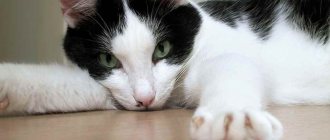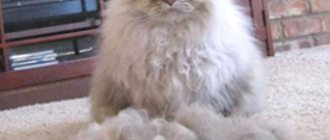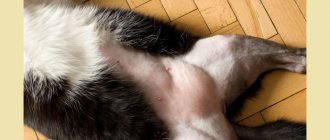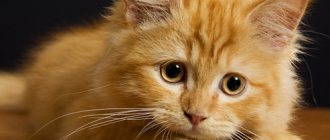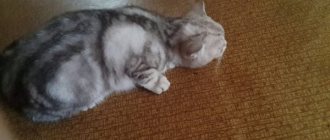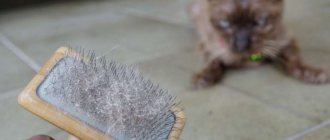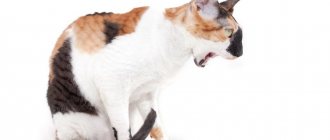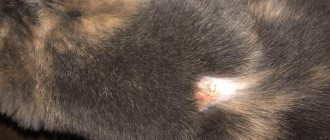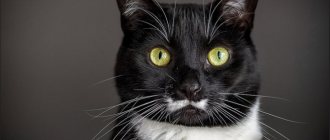We take care of the fur and take care of the cat’s health
The coat of a cat acts as an indicator that indicates the health status of the pet. Cats carefully lick their fur on their own, but cannot reach all places on their bodies. Therefore, it is necessary to care for fur of any length, especially during seasonal molting.
How grooming affects cat health:
- During combing, the skin is massaged, which means its blood supply improves,
- Combing with a brush minimizes the accumulation of hair in the animal's stomach,
- Timely combing prevents the formation of tangles, which lead to irritation of the pet’s skin underneath.
- Regular hygiene procedures help identify the first signs of skin and other pathologies in cats.
In addition to procedures directly with the hair (combing, bathing, cutting), nutrition and climate also affect the health of the coat.
in the house where the pet lives.
Nutrition
- the basis for the health of a cat's coat. In order for the coat to be strong, beautiful and shiny, the animal’s diet must include vitamins A, C and E, omega-3 and omega-6 polyunsaturated fatty acids, zinc and other nutrients. PURINA® PRO PLAN® industrial feeds meet these requirements.
PURINA® PRO PLAN® DERMA CARE food for adult cats belongs to the PRO PLAN® Nature Elements line, which combines natural oils, algae and plants. Due to its nutritional properties, flaxseed oil helps maintain the health of your cat's skin and coat.
For cats with sensitive skin, PRO PLAN® ELEGANT food with OPTIDERMA® formula, which not only maintains a healthy and beautiful coat, but also helps reduce excessive hair loss, controls the formation of hairballs and ensures the elimination of hair from the digestive tract.
The amount of food depends on the age, weight, and breed of the cat. The daily dosage is calculated by the manufacturer and indicated on the packaging. Don't forget about your pet's constant access to clean drinking water.
The condition of a cat’s fur also depends on the microclimate
in room. To maintain a comfortable microclimate, the air in the house needs to be humidified. Dry air makes the coat dull and the hair becomes brittle. Humidifiers and wet cleaning help maintain the required level of humidity.
Cats love to sleep in warm places and bask in the sun, but this can be dangerous, especially during the hotter months. Direct sunlight and hot heating appliances can cause your pet to overheat and affect its color. In sunny weather, keep the windows closed and make sure that the cat's sleeping place is away from radiators and heating devices.
Indoor microclimate
Is there a lot of yellow light bulbs in the house, is the air dry? In this case, the cat's fur may become dry and lifeless. For the health and beauty of your pet, pay attention to the microclimate in the house. Various ways can help improve it:
- frequent wet cleaning without the use of chemicals;
- regular ventilation of rooms;
- reducing heating intensity. If this is not possible, make sure that the cat does not sleep on the radiators. Equip her with a cozy house or bed;
- using a humidifier.
If you think you're doing everything right, but your cat's appearance still isn't up to par, visit your veterinarian. Coat problems can be symptoms of various diseases. Also, do not forget about routine medical examination, vaccination, and deworming of your pet. All this can help your cat be healthy for many years and delight you with its beauty and playfulness.
Examination of the cat's skin and fur
The skin protects cats from harmful environmental factors, provides thermoregulation, performs an excretory function, and participates in metabolic processes. Therefore, any changes in the skin affect the overall health of the pet, and disruptions in the functioning of internal systems affect the condition of the coat and skin.
To exclude the development of diseases and notice pathologies in time, the cat owner should regularly examine its fur and skin. What to look for during an inspection
:
- presence of parasites: fleas and ticks;
- appearance: is the coat shiny and what color is it;
- cat behavior: if your pet often licks certain areas of the skin, this may be a symptom of a disease;
- the presence of tangles in the wool;
- uneven skin;
- softness and silkiness of wool;
- uniform hair coverage of the skin: make sure that the hair maintains its natural shape;
- is there any inflammation: redness of the skin, swelling, soreness;
- skin elasticity.
Problems with the skin and coat may indicate some kind of internal disease, the presence of parasites or allergies. Take your cat to the vet to rule out serious pathologies. If your pet has sensitive skin, you should review their diet and take care of a balanced diet to improve skin health.
Causes of hair loss in cats
Over the course of its many years of experience, the Murkoshi team has repeatedly encountered such a problem as hair loss in cats. What reasons could there be for this? We will list the most common ones.
1. Natural causes
a) molting b) estrus c) age d) pregnancy c) hormonal imbalance
2. Diseases
a) improper functioning of organs b) adenitis c) hypotrichosis d) seborrhea e) parasites f) lichen g) folliculitis
3. Allergy
a) for food b) for medicines d) for environmental substances
Danger of tangles
A mat is a sticky lump of dead hair that is held together by new regrown hairs. A large mat looks like felt. Due to tangles, new wool grows worse and its quality decreases.
What else are dangerous about tangles:
- ventilation of the skin deteriorates,
- when a cat tries to comb a mat with its paw, the skin may be injured,
- under the mat the blood circulation of the skin is impaired,
- there is a risk of inflammation of the skin under the lump.
How and with what to remove the mat:
- If the lump is still small and not very stuck together, then you can try to untangle it with your hands. Before you begin, dampen the tangle with tangle spray.
- Loose mats can be combed out with a wide-toothed comb.
- For large tangles that cannot be untangled with your hands and combed through, use scissors or a special tangle cutter.
- After procedures to remove the mat, inspect the skin that was underneath it. Make sure your skin is dry and free of inflammation. If inflammation begins, contact your veterinarian.
To prevent the formation of dense and large ridges, regularly examine your cat and care for your pet's fur.
What to do if your cat is losing hair?
Do not forget that in case of skin diseases, you should always contact a veterinary clinic first, since the condition of the skin and hair is a reflection of malignant processes throughout the body and it is extremely difficult to determine the cause yourself. "Murkosha" does not recommend self-medication, because it often aggravates the health problems of pets.
Well, after the diagnosis has been made by a specialist, treatment should begin. The most common methods of treatment are taking antihistamines, washing with disinfectants, and eliminating allergens from the cat's diet. In some cases, antibiotics or even surgery may be necessary.
Short-haired cats: care features
Cats of any coat length need extra care. A cat is able to independently monitor the condition of its fur, but during shedding, the hair needs to be combed more thoroughly. In addition, if a pet lives in an apartment where the same microclimate is maintained throughout the year, hair falls out all year round.
A cat's tongue is rough to the touch due to the many tubercles (papillaries) located on its surface. During licking, the papillaries capture dead hairs. Due to the structure of the papillaries, the hairs fall into the cat's mouth and are swallowed. In the pet's stomach, fur accumulates in balls, which disrupt the digestion process.
Therefore, even short-haired cats need help getting rid of excess hair. These cats develop mats less frequently, so it is not difficult to take care of a pet with short hair. Basically, such care consists of combing. Short-haired cats are rarely bathed. Cats with short hair do not need haircuts.
Brushing cats with short hair
To accustom your cat to brushing, you should start the procedure from childhood. While the kitten's fur is short and not so thick, brushing will not bring much discomfort or pain. This will help reinforce a positive attitude towards the process as your pet grows up and eliminate the fear of a brush or comb.
To get an adult cat accustomed to grooming, do it in a positive environment. Reward your pet with treats or brushing during play. When combing, it is important not to make sudden movements that cause pain. If the cat is nervous and hisses, it is better to continue the procedure later.
What tools are suitable for combing short-haired cats?
:
- Brush-mitten
for painless collection of hair. Used for kittens or cats not accustomed to brushing. The mitten brush, together with stroking the pet, collects fallen hairs. - Iron comb
with two rows of teeth. The comb performs the main combing process. The fine-toothed side is used to comb through thick undercoat and tangled areas of the coat. To complete the process, the wool is combed with the fine-toothed side. Do not buy plastic combs, they electrify the hairs, which makes them even more tangled. - The massage brush
helps collect loose hair and improves blood circulation. This has a positive effect on coat renewal and helps avoid the formation of tangles. - The Furminator
is used to thin out the coat and remove loosely attached undercoat.
You can brush short-haired cats 1-2 times a week and regularly remove dead hair with a mitten brush or a damp hand.
Do cats with short hair need to be bathed?
The cat has sebaceous glands that protect the skin and fur by producing a special secretion. This natural defense can be compromised by frequent bathing. Short-haired cats are washed in case of heavy contamination, during treatment for parasites, or if the pet is preparing for an exhibition, but not more than once every six months.
For washing
For short-haired cats, the following
means
:
- shampoo that washes away impurities and restores hair structure,
- conditioner for shine and nutrition of wool,
- moisturizer to normalize sebum.
Do not use human products to bathe cats, as... The pH levels of cat and human skin are completely different.
To help your cat's fur dry faster, first blot off excess moisture with a towel. Then you can dry the fur with a hairdryer, but do not use the hot mode so as not to burn your pet's skin. Make sure the house is warm and protect the animal from drafts.
Causes of deterioration in wool quality
Negative changes in the coat include: hair loss, lack of shine, dryness/excessive oiliness, increased tendency to form tangles. Often the problems are a consequence of the “home” lifestyle:
- incorrect temperature conditions - this factor affects the metabolism and thermoregulation of the pet, making molting almost continuous, and new fur weak and sparse;
- nutrition – we are talking about an incorrect balance of proteins/fats/carbohydrates, vitamins/minerals. Also, the composition of the diet sometimes does not take into account features associated with the age and hormonal levels of the animal;
- stress – the cat may be disturbed by the appearance of another pet, noise, incorrect “bath” or grooming procedures;
- care – too frequent bathing, poor-quality cosmetics, insufficient/excessive combing;
- low physical activity and lack of fresh air - this also affects metabolism and the state of the immune system.
Conditional pathological reasons for changes in wool quality include:
- allergies - reactions to new foods or treats, food from the table, as well as medications or cosmetics;
- weakened state of the body - in kittens or older animals, during pregnancy/lactation or recovery from serious illnesses.
Among the diseases accompanied by deterioration of hair:
- enlargement/inflammation of the sebaceous glands – provokes excess sebum production and hair loss;
- parasitic and fungal infestations – fleas, lice, micromites, ringworm;
- dermatitis of various nature;
- hereditary (in Persian and exotic cats) and secondary seborrhea;
- hormonal disorders - thyroid disease, diabetes, disruptions due to sterilization or taking corticosteroids;
- diseases of the gastrointestinal tract, liver and kidneys;
- helminthiases;
- infectious and viral diseases;
- dental problems.
Long-haired cats: care features
Long-haired cats require more time to groom. This is due to the fact that long-haired cats are more likely to develop mats. When licking long fur, hairs enter the stomach, causing vomiting and loss of appetite, and can accumulate behind the fangs.
Long-haired cats need to be brushed regularly, bathed more often than short-haired cats, and trimmed if necessary.
Brushing cats with long hair
It is recommended to spend 15-20 minutes a day brushing your long-haired pet. If the cat is in a period of active shedding, then twice a day. As tools
used: mitten brush, iron comb with two rows of teeth, massage brush. A silicone brush is suitable for combing out the undercoat, which helps to painlessly remove fallen fluff.
To collect loose hairs, start stroking your cat with a mitten brush or silicone brush in the direction of the hair growth. Then use a wide-combed comb to comb in the direction of hair growth and finish with a fine-toothed comb.
Start with your pet's head, then move from the neck to the body, brushing the back and sides. If your pet allows you to lay him on his back, turn him over and brush his belly. Particular attention should be paid to the places where tangles form: behind the ears, in the armpits, on pants and tail.
If a tangle appears, try to disassemble it with your hands or use scissors. Long-haired cats need to be especially carefully checked not only for the presence of mats, but also for the condition of the skin and coat in general. Due to the length of the coat, abrasions, redness or parasites are not always noticeable. During hygiene procedures, examine your pet especially carefully.
